Myths & Fallacies
Myths & Fallacies

A great deal of folklore and misinformation has developed about the Sand House over the decades, such that it has taken on an almost mythological quality. Here are some of the most often-repeated myths and fallacies. Click on any myth below in order to see the details… and the truth!
Do You Know Differently?
If you have convincing evidence to support any of the claims that we have described as myths, please Contact Us. We are prepared to be proved wrong, if reliable evidence exists (i.e. not just hearsay). Thank you.
The Sand House was an underground dwelling... WRONG!

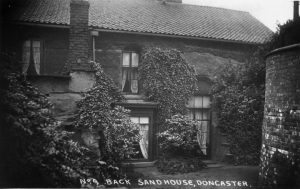
The Sand House stood above its immediate surroundings, on what had once been a quarry floor. In fact, it looked like a normal house, with a tiled roof, glazed windows, wooden doors and a garden around it. Where it differed was in its large size and the fact that its walls were natural sandstone. When the quarry was extended, a massive block of sandstone was left in place and hollowed out to form rooms. Although there was a tunnel network near to the house, those tunnels were never lived in. Any idea that the Sand House’s residents were some kind of cave-dwellers is very far from the truth.
There were several Sand Houses... WRONG!

There was only one Sand House, and yet people have often used the term “Sand Houses” to us. They are not correct. This misconception may come from the fact that the adjacent tunnel network included a series of chambers that might have given the impression of small habitable rooms… but they were not. No-one ever lived in the tunnels.
George Senior created the Sand House... WRONG!

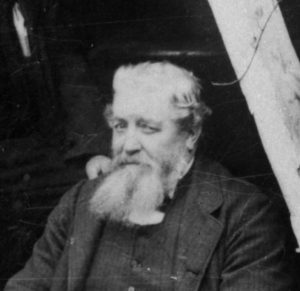
Henry Senior (pictured above) created and was the first resident of the Sand House. He lived there until his death, in 1900. For a period of over 20 years, from the early 1960s, almost every newspaper report about the Sand House named its creator as George ‘Sandy’ Senior. It was not until around 1984 that this matter was corrected and Henry began to be given the acknowledgement he deserved. (Henry did, in fact, have a brother, a son and a grandson named George, but none of them were instrumental in the creation or development of the Sand House.)
Tunnels ran for thousands of yards... WRONG!


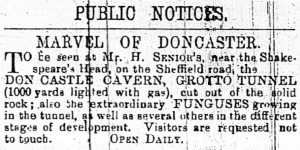
The tunnel network that was linked to the Sand House had, by 2019, been proven to a distance of about 300 yards (270 metres). There is also strong anecdotal evidence of other lengths of Sand House tunnels having existed in the area. While yet more tunnels may well remain to be discovered, there is no credible evidence that the total length ever exceeded 1000 yards. Through the latter years of the 19th century, the Sand House tunnels were thrown open to visitors. Advertisements in local newspapers sometimes stated the length of the tunnels that existed. The quoted figures gradually increased over the years, as more tunnels were dug. The maximum length reported in those adverts was 1000 yards, and that was less than 2 years before Henry Senior, the creator and owner, died.
Coffins & bones were falling into the tunnel... WRONG!
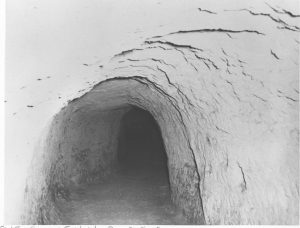
This one of the most often repeated claims. It is certainly the case that one of the tunnels linked to the Sand House has been proven to run beneath Doncaster Old (Hyde Park) Cemetery. However, an engineering survey carried out in 1964 studied this tunnel in detail and revealed no such intrusions from the burial ground above. Other evidence to disprove the ‘coffin story’ is that the tunnel in question runs directly beneath a path, rather than below graves. Also, the deepest graves in the cemetery are 2.7 metres (9 feet), but the tunnel roof is never less than 6 metres (20 feet) below the ground surface. Furthermore, we have an audio recording of a former Sand House resident, Thomas Hague, stating definitively that there were no collapses into the tunnel beneath the cemetery. (It is possible that there could have been another tunnel beneath the cemetery, but over 40 years of research has failed to find evidence of this.)
It is just possible that there is another, as yet undiscovered, tunnel under the cemetery, where coffins have fallen in. However, forty years of research have failed to find any credible evidence to that effect.
There is a tunnel entrance in Doncaster Old (Hyde Park) Cemetery... WRONG!

Most of the evidence that makes the ‘coffins and bones’ story extremely improbable applies to this myth, too. While, like so many other tales about the Sand House, this one is often repeated, there is no credible evidence to support it. We know precisely where the tunnel from the Sand House lies, under the cemetery. Close links with the Friends of Hyde Park Cemetery stretching back to 2003 have revealed nothing suggesting a tunnel access point there. When people who have repeated this story have been invited to show us the location, on site, they have not come forward to do so.
The Sand House was demolished in order to build flats... WRONG!

The Sand House was destroyed nearly three decades before any plans were drawn up to build apartment blocks in the locality. Having had its roof removed around 1938, the remains of the house were submerged soon after by landfill. The site of the house then remained untouched, as a wasteland, until 1964. That is when ground investigation work took place ahead of planning the area’s redevelopment. The fact is that, by the mid-1930s, the Sand House was deemed unfit for habitation and its owners had no further use for it, so it was destroyed. We wouldn’t even consider doing such a thing these days, but society’s attitudes were very different back in the 1930s.
The tunnels were filled in because buildings were subsiding... WRONG!

The tunnels were filled in because holes had begun to appear, without warning, in roads, paths and verges, as sections of tunnel roof below became weaker and collapsed. Because the tunnels were carefully surveyed and their locations mapped in 1964, before the apartment buildings were constructed, the new blocks were placed clear of the tunnels, in positions where they would not be affected.
There was an underground ballroom... WRONG!

The Sand House itself included a ballroom, at the eastern end of the upper floor of the house. It occupied about half of that floor. There was direct access from Victoria Street, down a staircase that led into the ballroom. During the 1890s, a band led by local musician and tradesman, Mr A. B. Dodds, provided the entertainment for regular dances at the Sand House. In the summer they took place in the garden, but in the winter they were held in the upstairs ballroom of the house.
Although the tunnel network that lay adjacent to the Sand House contained several chambers, none of them were anywhere near large enough to be used as a ballroom. Of course, there is the possibility that more excavations are yet to be discovered, but forty years of research have failed to come up with any credible evidence of an underground ballroom.
The Sand House was in Balby... WRONG!

The location where the Sand House once stood has never, as far as we can establish, been part of Balby, although it does lie quite close. The former ‘Urban District of Balby with Hexthorpe’ extended as far north as the centre of Green Dyke Lane, but the Sand House was a little farther north still, in the Municipal Borough of Doncaster. The current City of Doncaster Council Ward of Hexthorpe and Balby North lies to the south and the west of the Sand House site, with the actual site firmly within the Town Ward. Part of the reason for the Sand House being wrongly assigned by some people to Balby could be that it sits within what has become known as the Balby Bridge Estate (aka St James Street Estate)… but never in Balby.
Was the name 'Sand House' or 'Sandhouse' or something else?
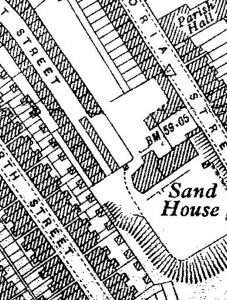

Before we published our first book about the Sand House, in 1988, we thought long and hard about what name we should use for this unique dwelling. The fact is that several different names have appeared on various documents over the past century-and-a-half. The 10-yearly Censuses, from 1861 to 1911, successively used the names Rock House; Senior’s Rock House; Rock House; Sand Pit House; Sand House; and Sand House again. Ordnance Survey maps of 1892 and 1903 used the name Don Castle, which appears to have been favoured by Henry Senior in his later life. However, by 1928, the OS had adopted Sand House. In 1897, the Doncaster Gazette referred to the Sand House, Don Castle Pleasure Ground. The Doncaster Chronicle also used Sand House, in 1900. The only known picture postcards that have produced (by Fred Heaviside c.1912 and William Green c.1920) are individually captioned as Sand House (mainly along with additional details).
The frequency with which Sand House was used to name the site, in official and semi-official documents, led us to adopt the same name.
In more recent times, there has been a tendency by many people to omit the space between the two words and to write Sandhouse. This concatenated version of the name does not seem to have been used widely, if at all, until the late twentieth century, long after the house had disappeared. Therefore, we avoid using this single word term and try to dissuade others from doing so, too. So, Sand House it is!
